No products in the cart.
Blog
How To Make T Shirt Quilt: Preserving Memories Stitch By Stitch
Are you looking for a creative way to cherish and preserve the memories associated with your old t-shirts? T-shirt quilts are an excellent solution! In this guide, we’ll walk you through the steps of how to make t shirt quilt.
Whether you’re a seasoned quilter or a complete beginner, you’ll find these tips and techniques helpful as you embark on this meaningful quilting journey.
Supplies You’ll Need
Before diving into the process, gather the following supplies:
- Stabilizer: Opt for a lightweight, woven stabilizer like Helon Shape-Flex 101. It shouldn’t be too heavy or gluey, as you want your quilt to remain soft and cuddly.
- Quilting rulers: A 12½-inch square grid ruler and a 6½-inch square grid ruler are ideal for cutting your t-shirt blocks accurately.
- Shears: Use regular shears, not snippers, as you’ll be doing a lot of cutting.
- Marker: A chalk marker works well for marking t-shirts but a regular pen can also be used as it will be cut off and won’t show.
- Pressing cloth: Consider using Clorox Handy Wipes or any other transparent, heat-resistant fabric for the best pressing results.
- T-shirts: Collect the t-shirts you want to include in your quilt.
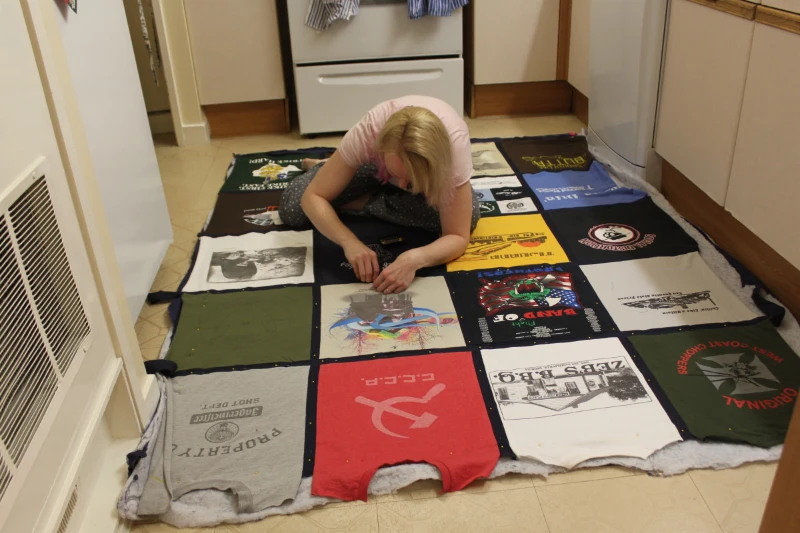
How To Make T Shirt Quilt: Step-By-Step Guides
Step 1: Gather Your T-Shirts
To begin crafting your t-shirt quilt, start by collecting the t-shirts you’d like to include. These can range from concert tees and sports jerseys to school memorabilia or any shirts holding sentimental significance.
Don’t fret over their condition; whether they’re old, well-worn, or brimming with sentimental value, they all have a place in your quilt.
Step 2: Choosing the Right Stabilizer
Not every t-shirt in your quilt requires a stabilizer. The decision hinges on the fabric’s weight and stretchiness. Consider these guidelines:
- Leggings: Leggings, known for their exceptional stretchiness and lightweight nature, benefit from stabilizers to avert distortion.
- Sweatshirts: Generally, thicker fabrics like sweatshirts don’t necessitate stabilizers due to their inherent sturdiness.
- Heavy T-shirts: T-shirts that are naturally robust and weighty can be done without additional stabilizers.
- Screen-printed t-shirts: When dealing with screen-printed t-shirts, always employ a pressing cloth to shield the design from smudging or melting during the pressing process.
The ultimate aim is to ensure that your quilt maintains a gentle, flowing, and cuddly texture. Therefore, your choice of stabilizer should align with this desired outcome.

Step 3: Cutting the T-Shirt Blocks
Now that you’ve established which t-shirts require stabilizer, let’s proceed to cut the t-shirt blocks with precision:
- Begin by placing your chosen t-shirt flat on a suitable surface.
- Utilize your 12½-inch square ruler to identify and isolate the desired design on the t-shirt.
- Carefully outline the square using a chalk marker or pen, ensuring it’s both centered and level.
- Execute a precise cut along the square’s boundary, allowing a slight overhang beyond the outline for accuracy.
- When working with smaller blocks, such as the 6½-inch square, employ the 6½-inch grid ruler to locate and delineate the design.
- Subsequently, cut out the smaller square, extending slightly beyond the outline for precision.
- In instances where larger shirts are involved, you have the option to fashion 12½-inch squares by uniting two 6½-inch squares seamlessly.
These meticulous steps will ensure your t-shirt blocks are uniformly cut and ready for the next phase of your quilt-making journey.
Step 4: Applying Stabilizer and Finalizing Blocks
Ensuring the stabilizer adheres securely is essential for your quilt’s longevity. Follow these steps carefully:
- Start by placing the stabilizer, with its glue side facing upward, on your work surface.
- Position the t-shirt block over the stabilizer.
- Shield the arrangement with a pressing cloth and apply firm pressure to firmly bond the stabilizer to the fabric.
- Employ your ruler as a guide to trim the block to its precise dimensions.
- Now, flip the block over, and using another pressing cloth on the fabric side, apply additional pressure for a final, secure attachment.
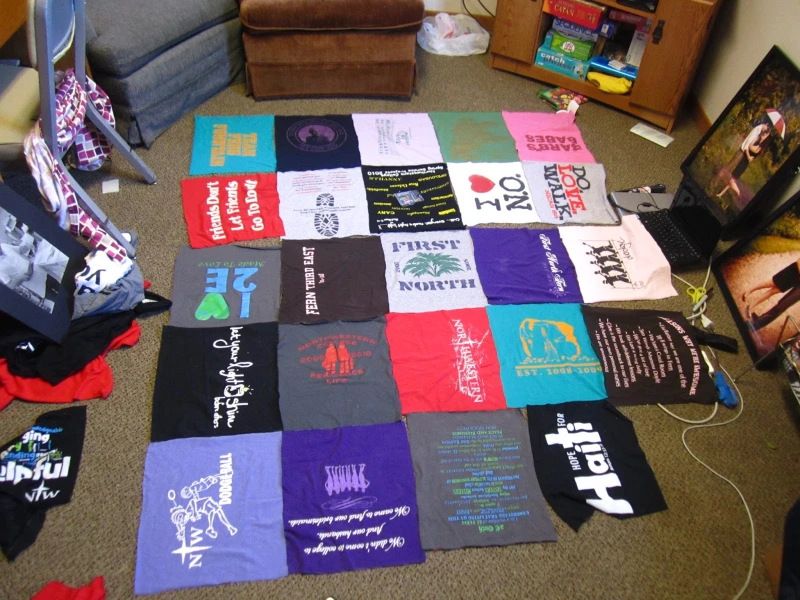
Step 5: Sewing the T-Shirt Blocks
With your t-shirt blocks primed and prepared, it’s time to unite them using sashing strips:
- Begin by cutting two-and-a-half-inch strips from your preferred fabric, typically referred to as sashing.
- Seamlessly stitch these sashing strips in between the t-shirt blocks to form rows of t-shirts.
- For a smoother finish, press the seams open to minimize any excess bulk.
Step 6: Customizing Your Quilt
T-shirt quilts are a canvas for personalization. Explore these creative ideas:
- Unique t-shirt sections: Infuse individuality by incorporating smaller t-shirt sections, pockets, or sleeves as distinctive blocks within your quilt.
- Diverse fabrics: Broaden your quilt’s texture and appeal by introducing non-t-shirt fabrics like flannel or cotton into the design.
- Intricate blocks: Dive into the world of foundation paper piecing to craft intricate blocks using smaller fabric scraps, adding a touch of complexity to your quilt.
- Sashing and borders: Elevate the aesthetics with complementary fabrics for sashing and borders, harmonizing with your t-shirt colors to enhance the overall look and feel of your creation.
How To Care For My DIY T-Shirt Quilt
Caring for your DIY t-shirt quilt is essential to ensure its longevity and keep it looking its best. After investing time and effort into creating a meaningful piece, you’ll want to preserve it for years to come. Here’s a guide on how to care for your t-shirt quilt:
Regular Cleaning
To maintain your quilt’s freshness, it’s a good practice to air it out periodically. Simply hang it outdoors on a sunny day or drape it over a railing. This helps to eliminate odors and keeps the fabric smelling clean.
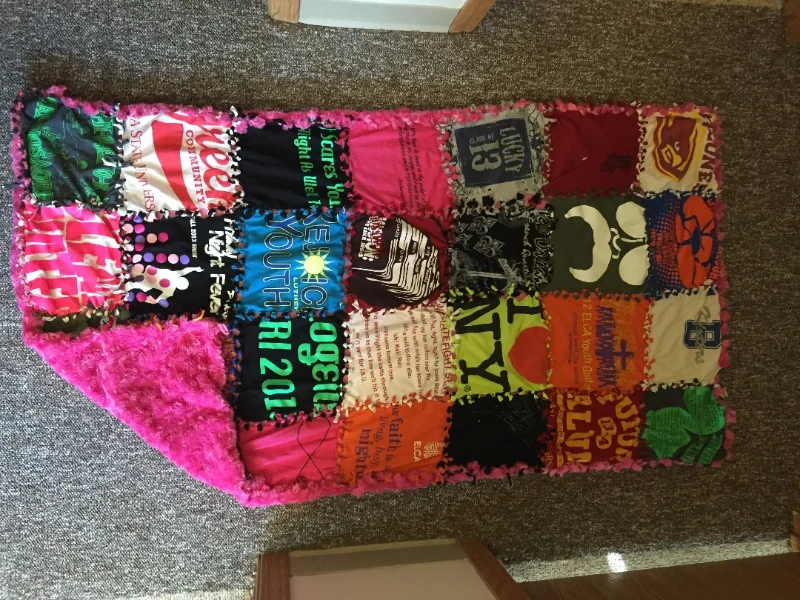
Spot Cleaning
If you happen to spill something on your quilt, address it promptly with spot cleaning. Gently blot the affected area with a clean, damp cloth and mild detergent. Avoid scrubbing, as it can damage the fabric and the quilt’s design.
Washing Instructions
While your t-shirt quilt may have sentimental value, it’s essential to check if the fabrics used can withstand washing.
If it’s machine washable, use a gentle cycle with cold water to prevent colors from fading. Place it in a laundry bag or pillowcase to protect it from abrasion in the machine.
Drying
When it comes to drying your quilt, avoid high heat settings, as they can cause fabric damage and shrinkage. Opt for a low heat or air-dry method to preserve the quilt’s quality. You can also fluff it in the dryer with no heat to remove excess moisture before laying it flat to dry completely.
Storage
When not in use, store your t-shirt quilt in a cool, dry place away from direct sunlight. Avoid hanging it for extended periods, as this can lead to stretching. Instead, fold it neatly to prevent creases and maintain its shape.
By following these care instructions, your DIY t-shirt quilt will remain a cherished keepsake for years, serving as a warm and comforting reminder of your memories.
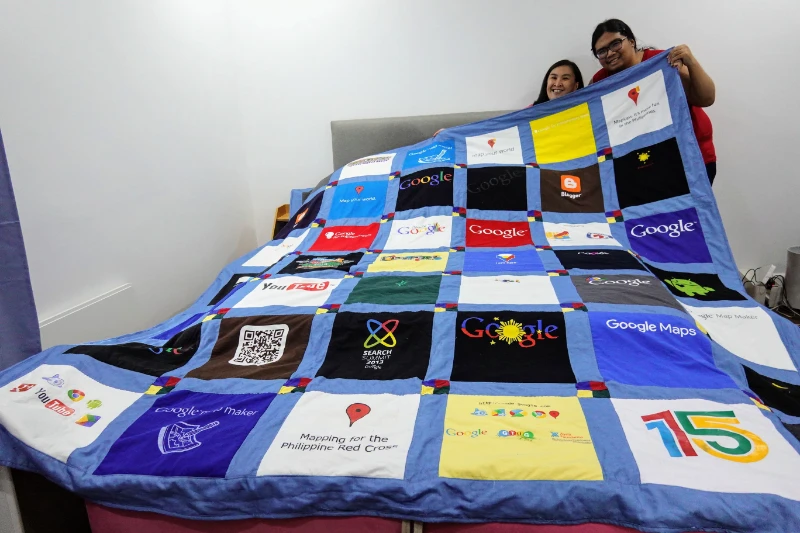
FAQs
Are T-Shirt Quilts Hard To Make?
T-shirt quilts can vary in complexity depending on your design and sewing skills. They are generally considered beginner-friendly quilting projects because they involve basic sewing and cutting techniques.
However, the difficulty level can increase if you choose intricate designs or opt for more complex quilt patterns. With proper instructions, patience, and practice, many individuals find t-shirt quilts to be an achievable and rewarding project.
How Many Shirts Do You Need To Make A Quilt?
The number of shirts needed to make a quilt depends on the size of the shirts and the desired quilt size. As a general guideline, you’ll need around 12 to 20 adult-sized t-shirts to create a lap-sized quilt.
For larger quilts or if your shirts are smaller in size, you may need more shirts. It’s essential to plan your layout and design before starting the project to determine the exact number of shirts required.
How Many Hours Does It Take To Make A T-Shirt Quilt?
The time required to make a t-shirt quilt can vary significantly depending on your experience level, the complexity of the design, and the size of the quilt. On average, it may take anywhere from 10 to 20 hours to complete a t-shirt quilt, including the time spent on cutting, stabilizing, sewing, and quilting.
More intricate designs or larger quilts may take longer. It’s advisable to set aside ample time and work at your own pace to ensure a well-crafted final product.
What Is The Difference Between A T-Shirt Quilt And A T-Shirt Blanket?
The primary difference between a t-shirt quilt and a t-shirt blanket lies in their construction and purpose.
- T-shirt quilt: A t-shirt quilt is typically made by sewing together t-shirt blocks to create a quilt top. It often includes batting and backing fabric, and it’s quilted to provide warmth and structure. T-shirt quilts are more structured and suitable for use on a bed or as a throw.
- T-shirt blanket: A t-shirt blanket is a simpler project where t-shirts are sewn together to create a blanket without the additional layers of batting and quilting. It’s more like a large patchwork throw and is often used for decorative or sentimental purposes, like displaying on a wall or couch. T-shirt blankets are softer and more flexible but provide less warmth compared to quilts.
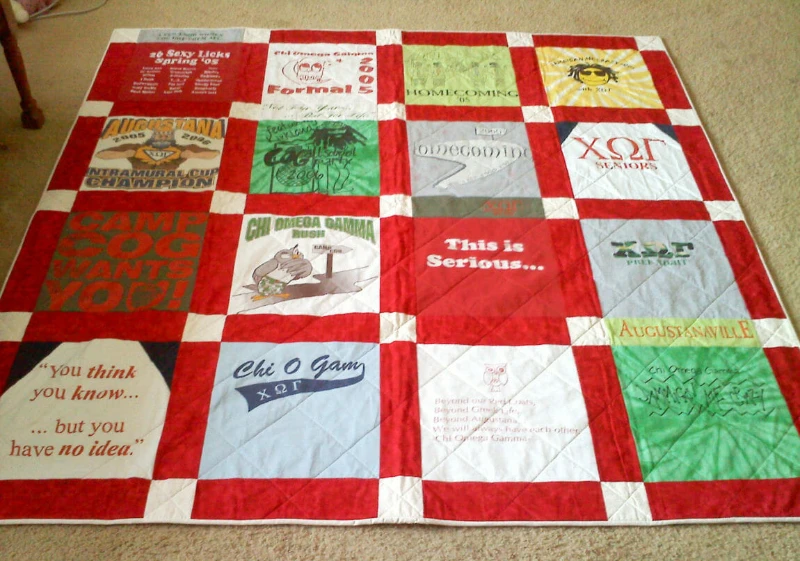
What Is The Best Size For A T-Shirt Quilt?
The ideal size for a t-shirt quilt depends on your intended use. Common sizes include lap-sized quilts, twin-sized quilts, or even larger options like queen or king-sized quilts.
Lap-sized quilts are great for snuggling on the couch, while twin-sized quilts are suitable for a single bed. Queen or king-sized quilts can cover larger beds or serve as decorative throws. The best size for your t-shirt quilt ultimately depends on your preferences and the number of t-shirts you have available.
What Is The Best Fabric For The Back Of A T-Shirt Quilt?
The choice of fabric for the back of your t-shirt quilt is flexible and largely dependent on your design preferences. Popular options include soft flannel, cotton, or minky fabric for added comfort and warmth.
You can choose a fabric that complements the colors and theme of your t-shirts. Ensure that the fabric is durable and comfortable, as it will be in direct contact with your skin or used as bedding.
What Color Thread For A T-Shirt Quilt?
The choice of thread color for your t-shirt quilt largely depends on your t-shirt designs and the overall aesthetic you want to achieve. Neutral colors like white, cream, or gray are safe choices that blend well with most t-shirt designs.
However, you can also select thread colors that match or complement the colors of your t-shirts. It’s a matter of personal preference, so feel free to get creative and choose a thread color that enhances the visual appeal of your quilt.
Can You Use Dry-Fit Shirts In A T-Shirt Quilt?
Yes, you can use dry-fit shirts in a t-shirt quilt. Dry-fit or moisture-wicking shirts are made from polyester or similar synthetic fabrics, which can be a bit trickier to work with than cotton.
To successfully incorporate them into your quilt, you may need to use a stabilizer to prevent stretching and puckering during the sewing process. Additionally, consider mixing dry-fit shirts with regular cotton shirts to achieve a balanced and comfortable texture in your quilt. With proper preparation, dry-fit shirts can be a unique addition to your t-shirt quilt.
Conclusion
T-shirt quilts are a wonderful way to transform your cherished memories into a cozy and sentimental keepsake. Whether you’re making one for yourself or as a gift for a loved one, each quilt tells a unique story.
How to make t shirt quilt? Gather those old t-shirts, follow these steps, and start creating your very own t-shirt quilt today. You’ll not only preserve your memories but also enjoy the warmth and comfort of a quilt that holds a piece of your life’s journey. Happy quilting!


